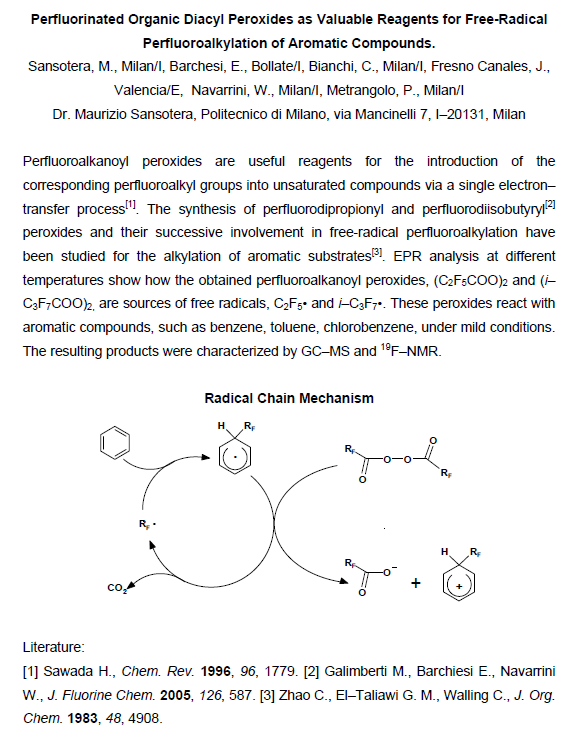2nd EuCheMS Chemistry Congress – 2008 September 16-20 – Torino, Italy
Simplified kinetic study of the reaction between perfluoro-methyl-hypofluorite and perfluoro-olefins
Navarrini Walter a*, Venturini Francesco a, Sansotera Maurizio a, Metrangolo Pierangelo a, Resnati Giuseppe a, Galimberti Marco b, Barchiesi Emma b, Dardani Patrizia b .
a Dipartimento di Chimica, Materiali e Ingegneria Chimica, Politecnico di Milano, 7, via Mancinelli, I-20131, Milano, Italy.
b Solvay-Solexis, R &D Centre, 20, viale Lombardia, I-20021 Bollate (MI), Italy.
In the reaction between perfluoroolefins and perfluoroalkylhypofluorites [1] the existence of two different free radical reaction mechanisms is demonstrated by the presence of characteristic by-products.
In particular in the reaction between trifluoromethyl hypofluorite and highly reactive perfluoroolefins like CF2=CFOCF3 and CF2=CF2, the free radical oligomerization and dimerization products can be suppressed by utilizing the opportune experimental conditions.
These experimental conditions are characterized by the presence of hypofluorite during the addition reaction and can be performed by adding the olefin to the hypofluorite, these conditions herein referred as ”Reverse hypofluorite addition” are different from the standard methodologies described in the literature where generally the hypofluorite is added to the olefin.
The main products of the addition of CF3OF to CF2=CFOCF3 are perfluoro-2,2-bis-(methoxy)-ethane and perfluoro-1,3-bis-(methoxy)-ethane [2] in the molar ratio of 20% and 80% respectively.
We found experimental evidence for the termination products peroxide CF3OOCF3 and perfluoroethersC8F18O4respectively. The first termination product CF3OOCF3 was present at high amount in the reaction where the CF3OF concentration was maintained always above zero and substantially constant, on the contrary the termination products C8F18O4 were completely absent. In this conditions the oligomerization and polymerization of the perfluoroolefins were also suppressed, as well as in the case of the very reactive TFE.
[1] W. Navarrini, V. Tortelli, A. Russo, S. Corti, J. Fluorine Chem. 95(2),(1999)27-39.
[2] W. Navarrini, G. Resnati, P. Metrangolo, M. Cantini, F. Venturini, IT Patent app. MI2007A001384 (2007).



